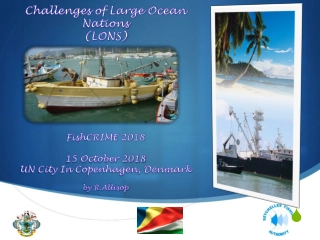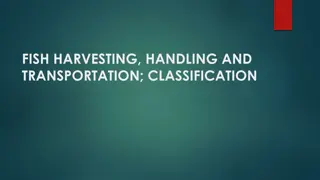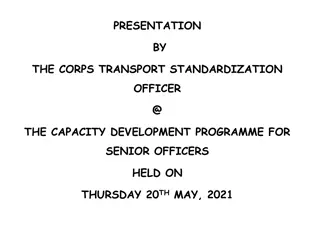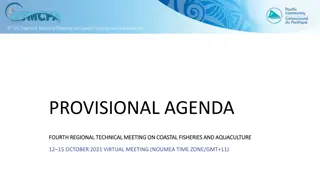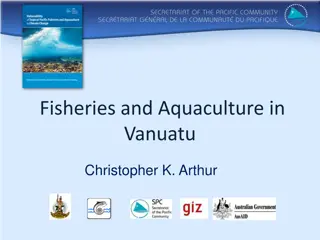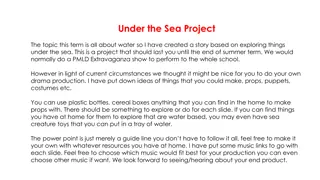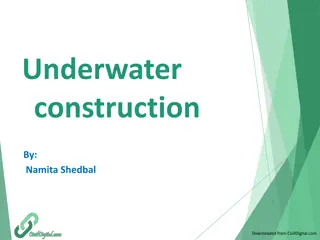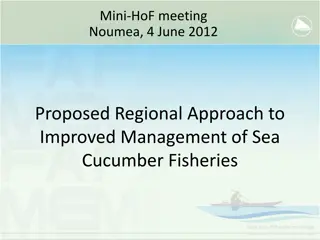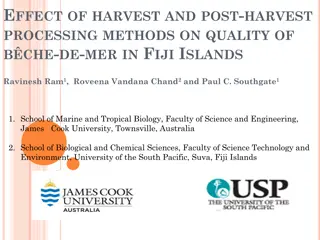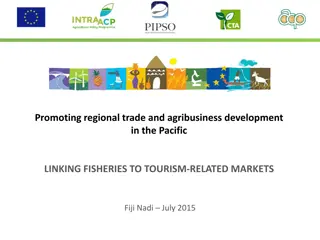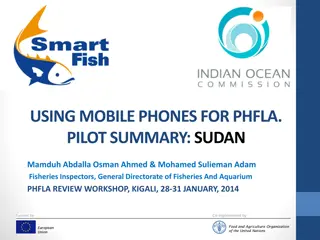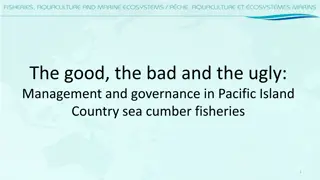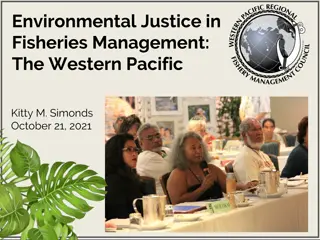Standardization of Underwater Resources Assessment in Pacific Sea Cucumber Fisheries
This study focuses on the challenges in assessing sea cucumber fisheries in the Pacific, emphasizing the need for standardization in methodologies, data collection, and capacity building. Lessons from regional studies highlight the importance of comprehensive surveys and species identification. Capacity building assistance and resource survey design are discussed as key components in improving management strategies for sustainable fisheries.
Download Presentation

Please find below an Image/Link to download the presentation.
The content on the website is provided AS IS for your information and personal use only. It may not be sold, licensed, or shared on other websites without obtaining consent from the author.If you encounter any issues during the download, it is possible that the publisher has removed the file from their server.
You are allowed to download the files provided on this website for personal or commercial use, subject to the condition that they are used lawfully. All files are the property of their respective owners.
The content on the website is provided AS IS for your information and personal use only. It may not be sold, licensed, or shared on other websites without obtaining consent from the author.
E N D
Presentation Transcript
The need for standardization of underwater resources assessment in the Pacific sea cucumber fisheries Andre Seale Kalo Pakoa, Frank Magron, Ian Bertram, Kim Friedman Coastal Fisheries Science and Management Section, DEC Western Australia
Challenges and constraints Limited understanding of sea cucumber fisheries, appreciation of its importance concern for better management Lack of or inconsistent information Surveys design to answer specific scientific question Inadequate geographical survey coverage Limited capacities in surveys that inform management Methodologies are inconsistent, lack of continuity Incomparability of results Confusion on methodologies and design Limited facility to process and store information Fisheries statistics can be complicated, daunting
Lessons from regional comparative studies SPC PROCFish/COFish 2002-2009 Baseline resources information 17 PICTs now available Varying complexities of reef systems -island types in the PICTs 80% of species found at high densities upper 10m Assessment this shallow provide good information Species composition vary-assess all species Manta tow and belt transects
Focused capacity building assistance (SCICOFish) On job training in-country and at SPC Collect resource information for advice Assessing all species and improve identification Collect count, lengths, and weight information, fishing data, community views Advice from fishers on aggregations Same methodologies, people and time across Encourage exchange trainings Include line agencies and NGO partners in training Use database system to store information Organize results into management advice
SC resource survey design Survey designs are based on sites Complexity of reef system Timing of surveys and purpose Funding available Capacity to use information Several methodologies to choose from Cost-effectively - manta tow and reef transects
SC resource survey design-example Example: Aitutaki Is , Cook islands Objective: Training and assessment Species :lollyfish, greenfish, surfredfish Status: un-fished Habitat: reef flat, reef crest, back reef Needs: 4 sectors Method: reef transect Personnel: 7 people -5 days Coverage: 12st/sector or 288 transects Information: species ID, size, weight Costs: sharing between CIMF and SPC
Reef transect surveys 40m x 1m x 6 transects per station 10-20 minutes per station 0-2 meters depth safe to use anywhere Species ID, size, count, habitat Simple, widely used
Manta tow surveys 300m x 2m transect takes 3-10 meters with goo visibility 10 minutes/transect Transects group into stations Easy to usw- need trained eyes Cover large area of reef in short time Broader understanding of distribution Less expensive and safe Used by countries
Standard record sheet for all methods Main record Habitat record
Data entry, verification, analysis, storage Reef fisheries integrated database (RFID) RFID in distribution to fisheries and NGO Trainings provided on database SPC maintain backup of data in Noumea Provided when needed
Species identification CODE BTF BF CF BCF GF DWBF PNF PRF SF STF SRF GSF WTF AF BSF CHF ETF SNF TF DWRF FF LF RLF PF LM WSF Trade names Black teatfish Blackfish Curryfish Brown curryfish Greenfish Deepwater blackfish Peanutfish Prickly redfish Sandfish Stonefish Surf redfish Golden sandfish White teatfish, Amberfish Brown sandfish Chalk fish Elephant trunkfish Snakefish Tigerfish Deepwater red fish Flowerfish Lolly fish Reef Lollyfish Pinkfish Loli s mother White snakefish Species Holothuria whitmaei Actinopyga miliaris Stichopus herrmanni Stichopus vastus Stichopus chloronotus Actinopyga palauensis Stichopus horrens Thelenota ananas Holothuria scabra Actinopyga lecanora Actinopyga mauritiana Holothuria lessoni Holothuria fuscogilva Thelenota anax Bohadschia vitiensis Bohadschia similis Holothuria fuscopunctata Holothuria coluber Bohadschia argus Actinopyga echinites Pearsonothuria graeffei Holothuria atra Holothuria atra Holothuria edulis Holothuria coronopertusa Holothuria leucospilota Fijian name Loloa Dri , Driloa Laulevu, Kari, Lakolako ni qio Laulevu Greenfish , Barasi Dri ni cakau Katapila Sucudrau Dairo Dritabua, Drivatu Tarasea Dairo kula Sucuwalu Basi, 4 corner Vula Mudra Tinani dairo, Dairo ni toba Yarabale, Samu ni uti Tiger, Vula ni cakau, Vula wadrawadra Tarasea Senikau Loliloli Loli ni cakau Loli piqi Tinani loli ?
Species presence by site and or country 30 26 26 26 25 24 25 22 22 21 20 species count 16 14 14 15 13 11 10 10 10 6 5 5 5 0 Provide information on resources available in a fishery Species that deserve management intervention Recovery of lost species -management measure is working
Count of species observed Effective closure 1662 1546 441 369 185 181 180 172 130 80 65 43 41 40 30 28 23 13 6 4 4 3 1 Ineffective closure 17 75 0 49 0 6 34 10 18 1 0 5 0 14 11 2 14 9 0 6 0 0 0 fishery open 3 186 20 166 4 46 6 13 3 0 2 0 0 1 23 0 1 3 0 2 0 0 1 fishery open 0 336 45 0 22 31 14 1 41 0 5 0 0 2 138 0 1 10 0 5 0 0 2 Trade name Chalkfish Lollyfish Curryfish Sandfish Greenfish Pinkfish Tigerfish Snakefish Brown sandfish Peanutfish Hairy blackfish Black teatfish Red snakefish Prickly redfish Flowerfish Golden sandfish White teatfish Elephant trunkfish Surf redfish Amberfish Brown curryfish Deepwater blackfish Stonefish all survey types, 5-10 people and 5-7 days of assessments
Species density by sites ind/ha Number likely present per hectare of reef Reference densities - ind/ha 10 200 150 120 100 1400 100 5600 1100 260 20 10 50 700 3500 100 30 Trade name Stonefish Surf-redfish Blackfish Tigerfish Flowerfish Chalkfish Brownsandfish Lollifish snakefish Pinkfish White teatfish Elephant trunkfish Black teatfish Sandfish Greenfish Curryfish Prickly redfish Species Actinopyga lecanora Actinopyga mauritiana Actinopyga miliaris Bohadschia argus Bohadschia graeffei Bohadschia similis Bohadschia vitiensis Holothuria atra Holothuria coluber Holothuria edulis Holothuria fuscogilva Holothuria fuscopunctata Holothuria nobilis Holothuria scabra Stichopus chloronotus Stichopus herrmanni Thelenota ananas Site density -ind/ha 20 150 300 121 93 2000 150 10000 200 260 2 4 37 400 3000 67 40 Red 41%; Yellow - 24%, Green - 35% 70+% above reference - good indication
Species density by depths across PICTS Stichopus pseudhorrens Thelenota rubralineata Holothuria fuscogilva Thelenota ananas 80% present at high densities in the upper 10m depth Holothuria edulis Thelenota anax Stichopus chloronotus Holothuria atra Holothuria fuscopunctata Bohadschia vitiensis Stichopus hermanni Bohadschia argus 94% present at maximum densities in the upper 10m depth Actinopyga miliaris Holothuria whitmaei Bohadschia graeffei Holothuria leucospilota Actinopyga mauritiana Actinopyga palauensis Holothuria coluber Actinopyga lecanora Holothuria scabra Deeper stocks need to be preserved as breeding reservoir Stichopus vastus Stichopus monotuberculatus Stichopus horrens Holothuria lessoni Holothuria impatiens Actinopyga sp. Holothuria Lessoni Holothuria flavomaculata Holothuria pervicax Bohadschia similis Actinopyga spinea Actinopyga echinites Holothuria difficilis Holothuria cinerascens 0 5 10 15 20 25 30 35 mean depth of densities over 100ind/ha (m)
Population size structure (Sandfish) population change -fishing and management measure no take preserve breeding stocks
Stock estimation Step 1: Assess resources status indicators Step 2: Stocks not fully recovered - further resting proposed, more surveys Step 3: Stocks show signs of maturity stock estimation Stock estimation is extrapolating densities by reef habitat area to produce stock estimate in number and weight and certain proportion as harvestable quantity(wet and dry weights)
Progress made in PICTs Over 30 new assessments Information managed at SPC Used to advices to countries Invertebrate manual, creel and market survey manual
Opportunity While we do acknowledge there are several useful ways of assessing sea cucumbers resources Our experience have shown that standardizing assessments is good for the region therefore SPC welcomes the opportunity to come together to continue this progress - share lessens, exchange ideas and experiences towards better informed management of sea cucumber fisheries. Countries are encouraged to take lead role in this effort
Questions or talk to us or email Kalop@spc.int Frankm@spc.int Ianb@spc.int or Friedman et al 2008. Sea cucumber fisheries: A managers tool Box Friedman et al 2010. Management of sea cucumber stocks Eriksson et al 2010. Resources status in Zanzibar, Tanzania Eriksson et al 2013. Population metrics for Curryfish, One Tree Reef, GBR Thankyou


